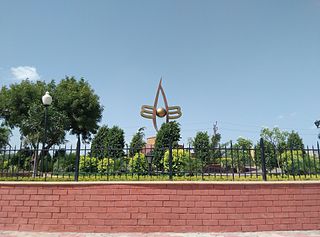
Nathdwara is a city in the Rajsamand district of the state of Rajasthan, India. It is located in the Aravalli hills, on the banks of the Banas River and is 48 kilometres north-east of Udaipur. Shrinathji, is a swarup of lord Krishna which resembles his 7-year-old "infant" incarnation of Krishna. The deity was originally worshiped at Jatpura, Mathura and was shifted in the year 1672 from Govardhan hill, near Mathura along holy river Yamuna after being retained at Agra for almost six months. Literally, Nathdwara means 'Gateway to Shrinathji (God)'.
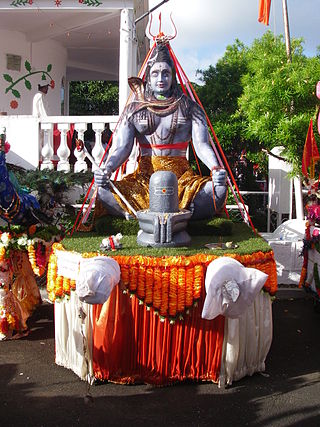
Maha Shivaratri is a Hindu festival celebrated annually in honour of the deity Shiva, between February and March. According to the Hindu calendar, the festival is observed on the fourteenth day of the first half of the lunar month of Phalguna. The festival commemorates the wedding of Shiva and Parvati, and the occasion that Shiva performs his divine dance, called the Tandava.
Navagraha (Pron: nævəˈgrɑ:ə) pilgrimages are pilgrimages devoted to Navagraha—the nine (nava) major celestial bodies (Grahas) of Hindu astronomy. These temples are made of stone. These celestial bodies are named Surya (Sun), Chandra (Moon), Mangala (Mars), Budha (Mercury), Brihaspati (Jupiter), Shukra (Venus), Shani (Saturn), Rahu and Ketu. Many temples in South India contain a shrine dedicated to the Navagrahas. However, the term Navagraha temples refers to a cluster of nine separate temples, each an abode of one of the Navagrahas.
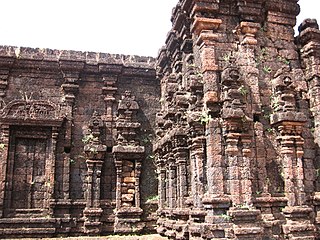
The Rajarajeshwara temple is a Shiva temple located in Taliparamba in Kannur district of Kerala State of India. The temple is regarded as one of the existing 108 ancient Shiva Temples of ancient Kerala. It also has a prominent place amongst the numerous Shiva temples in South India. It had the tallest shikhara amongst the temples of its time. The Rajarajeshwara temple has a top of about 90 tonnes. If any problem is encountered in the other temples of South India, devotees seek a solution in this temple through a prashnam, a traditional method of astrological decision-making. The prashnam is conducted on a peedha outside the temple.
Prabhas Patan, historically named Dev Patan, is a locality in Veraval, Gujarat. As the site of the Somnath temple and its associated Jyotirlinga, it is an important place of Hindu pilgrimage.

Dakshinamurti is an aspect of the Hindu god Shiva as a guru (teacher). He is regarded to be the personification of the supreme or the ultimate awareness, understanding, and knowledge. Dakshinamurti represents Shiva as a teacher of yoga, music, and wisdom, offering an exposition of the Shastras. He is worshipped as the god of wisdom and meditation.

Parikrama or Pradakshina is clockwise circumambulation of sacred entities, and the path along which this is performed, as practiced in the Indic religions – Hinduism, Buddhism, Sikhism and Jainism. In Buddhism, it refers only to the path along which this is performed. In Indic religions, the parikrama is typically done after completion of traditional worship and after paying homage to the deity. Parikrama must be done with dhyāna.

The Saptakoteshwar temple at Narve in Goa, India, is considered to be one of the six great sites of temples of Shiva in the Konkan area.
Kayavarohan or Karvan is a village in the Vadodara district of the state of Gujarat, India. Kayavarohan is popularly known as Karvan. It is 11 km from the National Highway 48 and 30 km from Vadodara. Kayavarohan is considered as the birthplace of Lakulisha, the second century C.E. Shaivite revivalist, reformer and propounder of the pashupata doctrine. It is an important religious place on account of its Lakulisha temple.
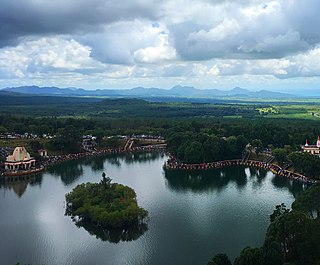
Ganga Talao is a crater lake situated in a secluded mountain area in the district of Savanne, deep in the heart of Mauritius. It is about 550 m (1,800 ft) above sea level. It is considered the most sacred Hindu place in Mauritius. The first group of pilgrims to Ganga Talao were from the village of Triolet and led by Giri Gossayne from Terre Rouge in 1898.
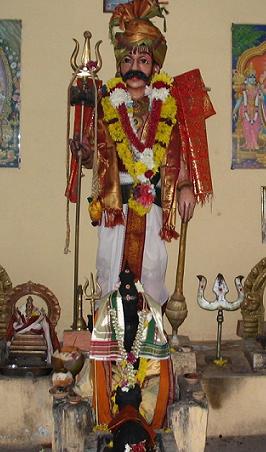
Muneeswarar, or Muneeswaran, is a popular Hindu deity within Hinduism, and is worshipped by many, in countries such as India, Malaysia, Singapore, Indonesia, Fiji and many more. He is sometimes referred to by different names, such as Muniyandi, Muniyappan, Muni Ayya, Ayya amongst many others. Muneeswarar is mostly considered a guardian deity or minor, but is in some cases hierarchically considered to be on par with Lord Shiva, one of the main deities in the Hindu trinity. Although not much is known on the exact origins and history of Muneeswarar, he is often regarded to be related to the Hindu Lord Shiva. His name is a combination of "Muni", and "Ishvara", an epithet or title of Shiva.
A shikharbaddha mandir is a traditional Hindu or Jain place of worship, typically featuring architecture characterized by superstructures with towers pinnacles and domes and often built of carved marble, sandstone, or other stone. While such mandirs are common in many branches of Hinduism, the use of the term shikharbaddha mandir to describe such mandirs is most common in the Swaminarayan branch of Hinduism as well as Jainism. The opposite of the shikharbaddha temple is one without a shikhara tower, i.e. with a flat roof.
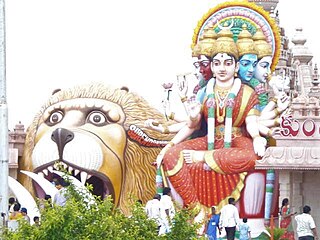
Surendrapuri is a religious tourism destination located near Hyderabad, Telangana, India in the Yadadri Bhuvanagiri district. The 17-acre religious complex includes the Kunda Satyanarayana Kaladhamam - India's first mythological museum, Panchamukha Hanumadeeswara Devasthanam (Hindu temple), Navagraha temples, Nagakoti idol, and Surendrapuri’s iconic two-sided Panchamukha Hanuman-Shiva statue.
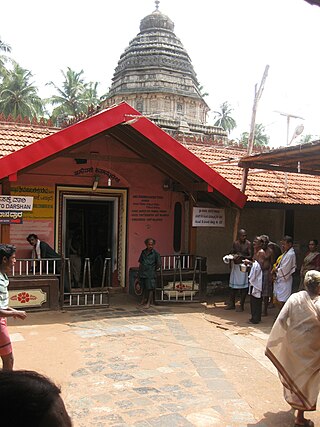
The Mahabaleshwar Temple, Gokarna is a 4th-century CE Hindu temple located in Gokarna, Uttara Kannada district, Karnataka state, India which is built in the classical Dravidian architectural style. It is a site of religious pilgrimage. The temple faces the Gokarna beach on the Arabian Sea. The temple deifies the Pranalinga also called Atmalinga or Shiva Linga In legend, it is said that the deity of the temple will bestow immense blessings to devotees, even to those who only glimpse it. Currently the administrative charge of the temple is with an Overseeing Committee under the Chairmanship of Justice BN Srikrishna, a Retired Justice of the Hon'ble Supreme Court of India. It is one of the 275 paadal petra sthalams expounded in the Tevaram, a sacred Tamil Shaivite text written during the 6th and 7th centuries by 63 saints called Nayanars.

Uthirakosamangai, also known as Mangalanatha Swamy temple, is a Shiva temple situated near Ramanathapuram in the Ramanathapuram district of Tamil Nadu. Uthirakosamangai temple is located on an area of about 20 acres.
The Mithrananthapuram Trimurti Temple is a Hindu temple complex in Thiruvananthapuram, Kerala, India. It is a temple in where devotees get to offer worship to all the three Trimurti deities, namely,. The Temple is located on the western side of Padmanabhaswamy temple in Thiruvananthapuram.

The Thirunakkara Mahadevar Temple situated in the heart of Kottayam is one of the 108 revered Shivalayas in central Kerala, India. The temple is about 500 years old and was built by the Raja of Thekkumkur. It also preserves a number of unique sculptures and murals of various Hindu deities. A common belief is that the idol of Shiva here is installed by Parashurama. The Thekkumkur royal family considered the idol as their paradevatha in the form of "Thirunakkara thevar"

Shivoham Shiva Temple is a Hindu temple, situated on Old Airport Road, Bangalore, India, dedicated to the Hindu deity Shiva. Built in 1995, it features a 65 feet (20 m) statue of Shiva. The temple attracts an estimated 500,000 worshippers and visitors each year, including between 100,000 and 150,000 on the occasion of Maha Shivaratri.
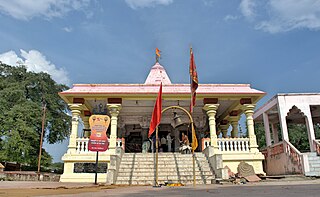
Kal Bhairav temple is a Hindu temple located in the Ujjain city of Madhya Pradesh, India. It is dedicated to Kal Bhairav, the guardian deity of the city. Located on the banks of the Shipra River, it is one of the most active temples in the city, visited by hundreds of devotees daily. Liquor is one of the offerings made to the temple deity.














